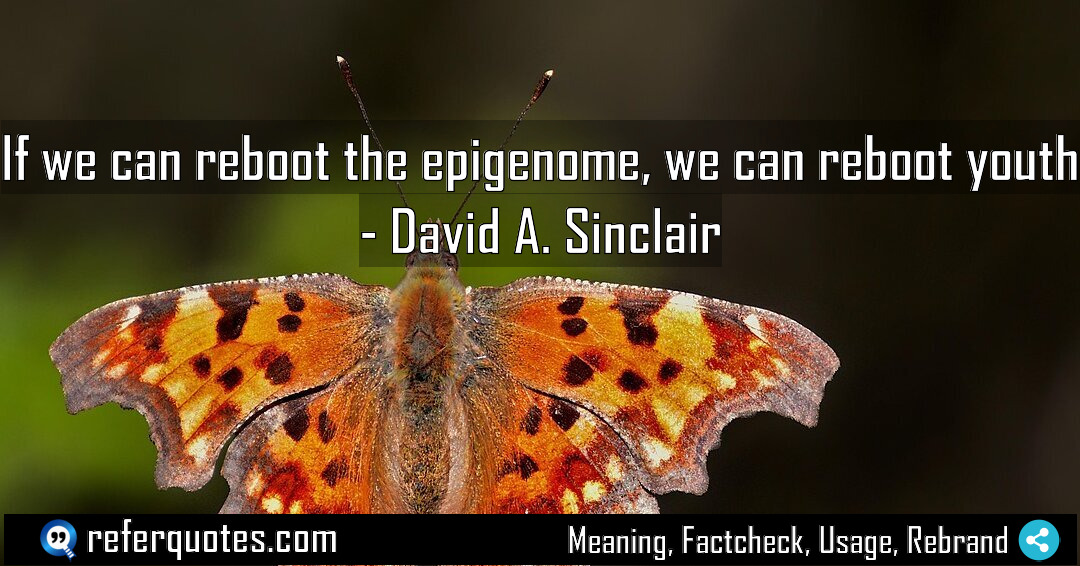
If we can reboot the epigenome, we can reboot youth. That’s the powerful, almost sci-fi idea from David Sinclair that’s shaking up longevity science. It suggests aging isn’t a one-way street, but a software glitch we can potentially fix.
Share Image Quote:
Table of Contents
Meaning
At its core, this quote means that youthfulness is an information state. It’s not just about worn-out parts; it’s about lost instructions. And if we can restore those instructions, we can, in effect, turn back the biological clock.
Explanation
Okay, so let’s break this down. Think of your DNA as the hardware of your computer—it’s the basic blueprint. The epigenome is the software. It’s a layer of chemical tags and proteins that sits on top of your DNA and tells your genes what to do, when to do it, and in which cell. It’s the reason a skin cell knows it’s a skin cell and not a liver cell.
Now, the theory—and Sinclair’s life’s work—is that aging is largely caused by epigenetic noise. Over time, due to stress, DNA damage, just… life… this software gets corrupted. The wrong genes get turned on, the right ones get turned off. The cell forgets its identity. This is the “epigenetic landscape” getting blurry.
So, “rebooting the epigenome” isn’t about changing your genes. It’s about resetting the software back to a youthful, pristine state. Clearing the noise. Making the cell remember how to function like it did when it was young. And if you can do that for enough cells? You’re not just treating a disease, you’re addressing the root cause of aging itself. You’re rebooting the system.
Quote Summary
Reading Level85
Aesthetic Score76
Origin & Factcheck
This line comes straight from David A. Sinclair’s 2019 book, Lifespan: Why We Age—and Why We Don’t Have To. It’s a central thesis of his work at Harvard Medical School. You sometimes see similar ideas floating around in wellness circles, but this specific, powerful phrasing is unequivocally his, born from decades of his lab’s research into epigenetics and cellular reprogramming.
Attribution Summary
Where is this quotation located?
| Quotation | If we can reboot the epigenome, we can reboot youth |
| Book Details | Publication Year: 2019; ISBN: 978-1501191978; Last edition: 2020; Number of pages: 432. |
| Where is it? | Chapter 2: The Information Theory of Aging, Approximate page 70 from 2019 edition |
Context
In the book, this isn’t just a hopeful throwaway line. It’s the culmination of a argument he builds piece by piece. He lays out the evidence for the Information Theory of Aging, positioning the epigenome as the primary player, not just a bystander. He’s essentially saying, “We’ve found the master control panel, and now we’re figuring out how to push the reset button.”
Usage Examples
You’d use this quote when you want to shift a conversation about aging from fatalism to possibility.
- For a Biotech Investor: “Look, the market is flooded with supplements that tweak one pathway. But the real paradigm shift, the moonshot, is in what Sinclair is saying: If we can reboot the epigenome… That’s the platform technology that changes everything.”
- For a Skeptical Colleague: “I know it sounds wild, but the data is getting hard to ignore. It’s not about immortality; it’s about healthspan. The goal is to keep the software running clean for longer. That’s the real reboot we’re after.”
- For a Patient Interested in Longevity: “Instead of just fighting individual diseases, the new science is asking how we can help the body repair itself more effectively. It’s about restoring the body’s innate youthfulness from the inside out.”
To whom it appeals?
Share This Quote Image & Motivate
Motivation Score70
Popularity Score68
Shareability Score72
FAQ
Question: Is this actually possible right now?
Answer: In humans? Not yet. But in lab mice, Sinclair’s team has successfully restored vision in old, blind mice by resetting their retinal cells’ epigenomes. So the proof-of-concept is there. We’re in the early, but incredibly exciting, translational phase.
Question: How do you “reboot” an epigenome?
Answer: The most promising method involves using what are called Yamanaka factors. These are proteins that can reprogram an adult cell back into an embryonic-like stem cell—a total epigenetic reset. The trick, and it’s a huge one, is doing this partially and safely inside a living body without causing cancer (which is what full reprogramming does).
Question: So, does this mean we can reverse aging completely?
Answer: That’s the ultimate goal, but the field is focused first on reversing age-related diseases by making tissues function youthfully again. Think of it as a tune-up for your entire cellular system, not a guarantee of living forever.
Question: What can I do today to support my epigenome?
Answer: While we don’t have a magic reboot pill, lifestyle factors known to support epigenetic health include things like intermittent fasting, intense exercise, and reducing chronic inflammation. These are thought to put a mild, beneficial stress on the system that helps keep the epigenetic software cleaner.
Similar Quotes
You know, when David Sinclair says “Youth is not a phase; it’s a pattern,” he’s flipping the script on everything we thought we knew about aging. It’s not an inevitable…
Every cell carries the memory of youth is a powerful idea from David Sinclair’s work. It suggests aging isn’t a one-way street, but more like a software glitch we can…
We don’t have to accept aging as inevitable. It’s a radical shift from thinking we’re just passengers on the aging train to realizing we might be the engineers. This quote…
You know, when David Sinclair says “Aging is not the opposite of youth,” he’s flipping the script on how we see getting older. It’s not about gaining wrinkles, it’s about…
So, this idea that “The real fountain of youth is within us” is a game-changer. It completely reframes aging from something that just happens to us, to a biological process…
